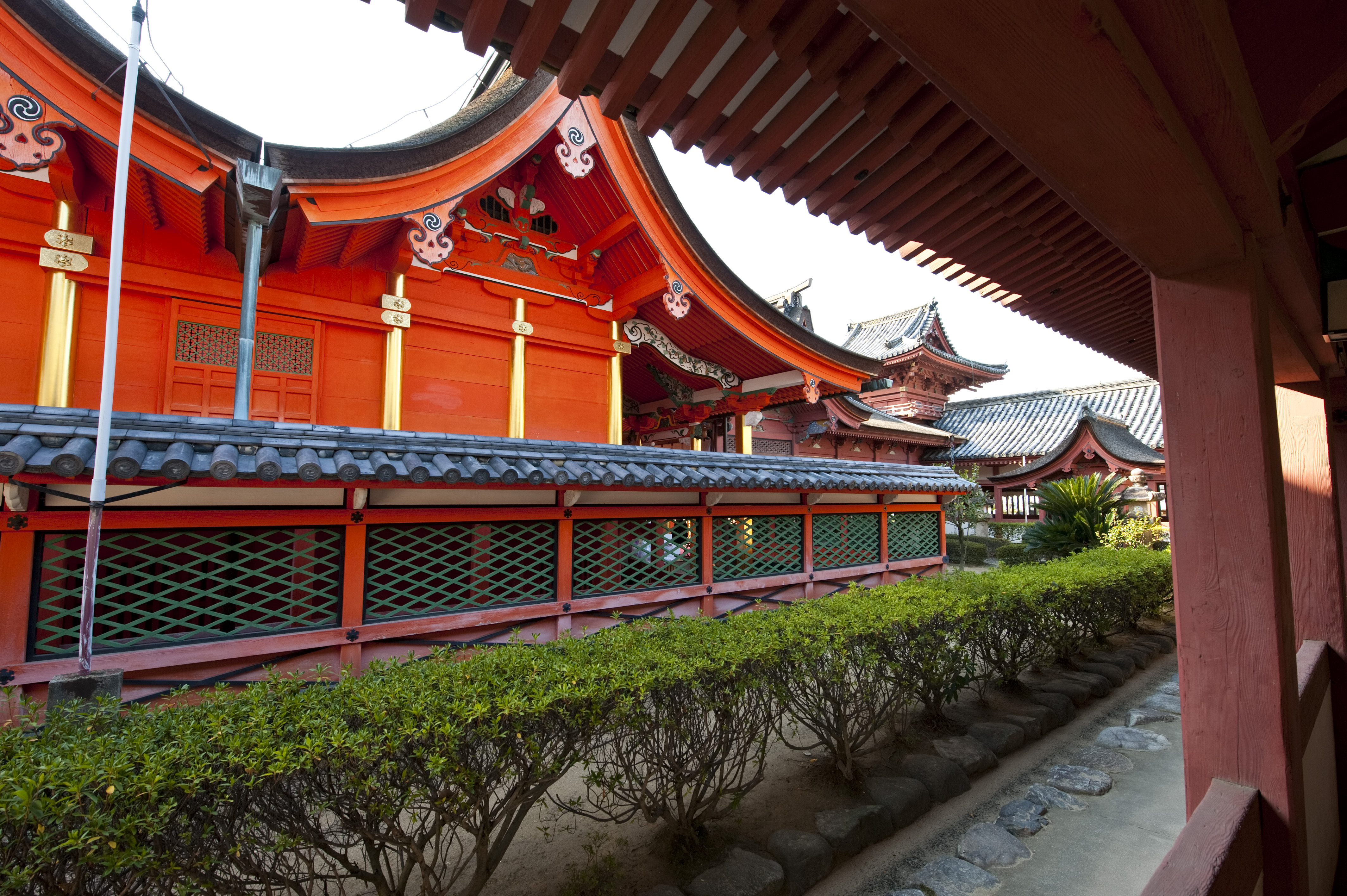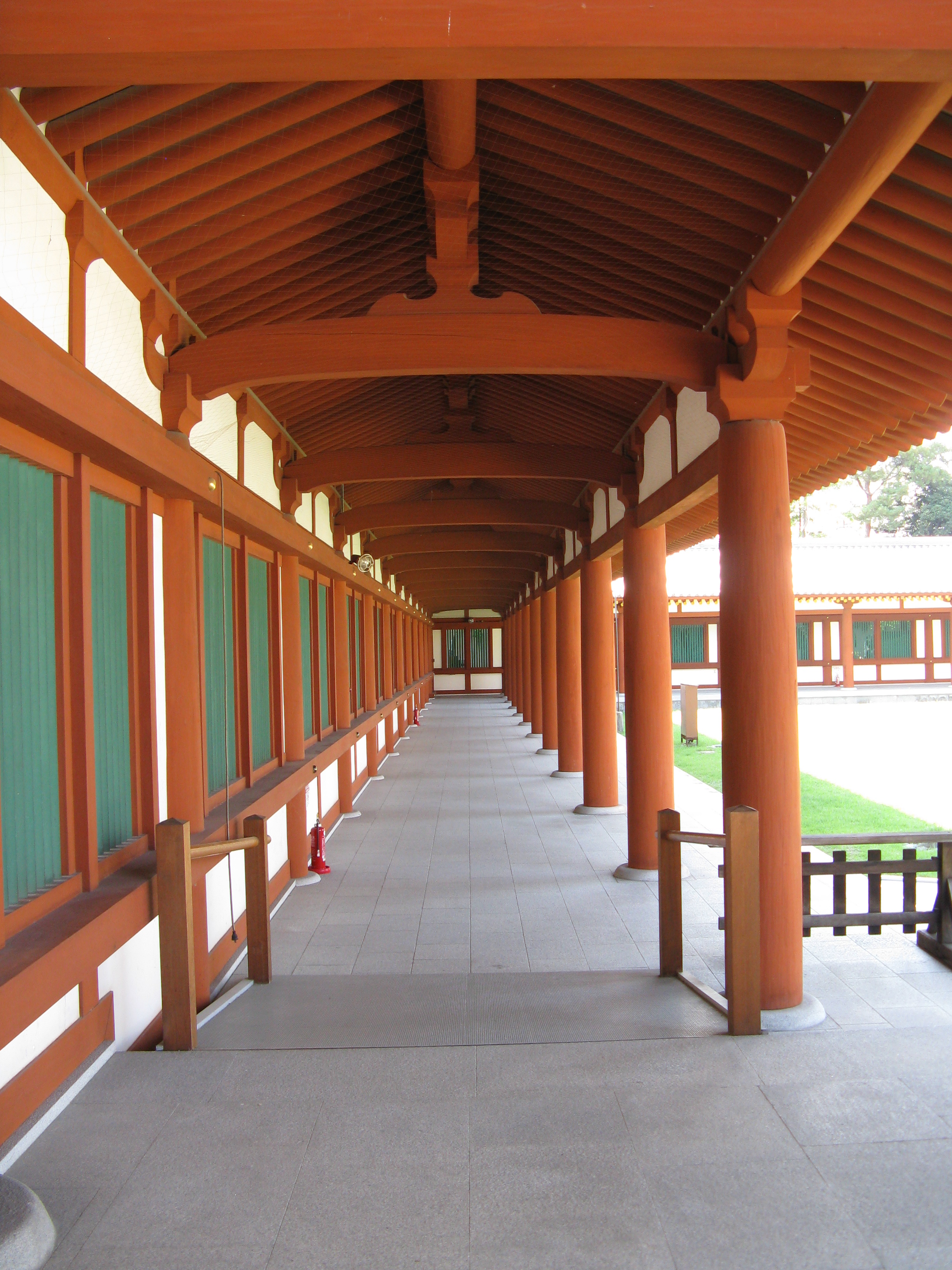|
Isaniwa Jinja
is a Shinto shrine in Matsuyama, Ehime Prefecture, Japan. Enshrined are Emperor Chūai, Empress Jingū, and Emperor Ōjin. A number of its buildings and treasures have been designated Important Cultural Properties. History It is said that the shrine was founded on the site where Emperor Chūai and Empress Jingū bathed at Dōgo Onsen and it is mentioned in Engi shiki. In the fourteenth century the Kōno clan moved the shrine to its present location and it was rebuilt by the Matsudaira clan in the seventeenth century. Isaniwa Jinja was restored in 1970. Buildings Isaniwa Jinja is modelled upon Iwashimizu Hachiman-gū in Kyoto Prefecture and constructed in the Hachiman-zukuri style. * Honden (1667) ( Important Cultural Property) * Mōshidono corridor (1667) (ICP) * Rōmon (1667) (ICP) * Kairō (1667) (ICP) * Massha (ICP) Treasures A treasure hall houses a number of swords and suits of armour. * Tachi (Kamakura period The is a period of Japanese history that marks the ... [...More Info...] [...Related Items...] OR: [Wikipedia] [Google] [Baidu] |
Shinto
Shinto () is a religion from Japan. Classified as an East Asian religion by scholars of religion, its practitioners often regard it as Japan's indigenous religion and as a nature religion. Scholars sometimes call its practitioners ''Shintoists'', although adherents rarely use that term themselves. There is no central authority in control of Shinto, with much diversity of belief and practice evident among practitioners. A polytheistic and animistic religion, Shinto revolves around supernatural entities called the . The are believed to inhabit all things, including forces of nature and prominent landscape locations. The are worshiped at household shrines, family shrines, and ''jinja'' public shrines. The latter are staffed by priests, known as , who oversee offerings of food and drink to the specific enshrined at that location. This is done to cultivate harmony between humans and and to solicit the latter's blessing. Other common rituals include the dances, rites of pass ... [...More Info...] [...Related Items...] OR: [Wikipedia] [Google] [Baidu] |
Kamakura Period
The is a period of Japanese history that marks the governance by the Kamakura shogunate, officially established in 1192 in Kamakura by the first ''shōgun'' Minamoto no Yoritomo after the conclusion of the Genpei War, which saw the struggle between the Taira and Minamoto clans. The period is known for the emergence of the samurai, the warrior caste, and for the establishment of feudalism in Japan. During the early Kamakura period, the shogunate continued warfare against the Northern Fujiwara which was only defeated in 1189. Then, the authority to the Kamakura rulers waned in the 1190s and power was transferred to the powerful Hōjō clan in the early 13th century with the head of the clan as regent (Shikken) under the shogun which became a powerless figurehead. The later Kamakura period saw the invasions of the Mongols in 1274 and again in 1281. To reduce the amount of chaos, the Hōjō rulers decided to decentralize power by allowing two imperial lines – Northern and Southern ... [...More Info...] [...Related Items...] OR: [Wikipedia] [Google] [Baidu] |
Tachi
A is a type of traditionally made Japanese sword (''nihonto'') worn by the samurai class of feudal Japan. ''Tachi'' and ''katana'' generally differ in length, degree of curvature, and how they were worn when sheathed, the latter depending on the location of the ''mei'' (銘), or signature, on the tang. The ''tachi'' style of swords preceded the development of the ''katana'', which was not mentioned by name until near the end of the twelfth century. ''Tachi'' were the mainstream Japanese swords of the Kotō period between 900 and 1596. Even after the Muromachi period (1336–1573), when ''katana'' became the mainstream, ''tachi'' were often worn by high-ranking samurai. History The production of swords in Japan is divided into specific time periods: * ''Jōkotō'' (ancient swords, until around 900) * ''Kotō'' (old swords from around 900–1596) * ''Shintō'' (new swords 1596–1780) * ''Shinshintō'' (new new swords 1781–1876) * ''Gendaitō'' (modern or contemporary sw ... [...More Info...] [...Related Items...] OR: [Wikipedia] [Google] [Baidu] |
Setsumatsusha
and , also called Iwanami Japanese dictionary, 6th Edition (2008), DVD version. (collectively known as The term ''setsumatsusha'' is the combination of the two terms ''sessha'' and ''massha''.) are small or miniature shrines entrusted to the care of a larger shrine, generally due to some deep connection with the enshrined ''kami''. The two terms used to have legally different meanings, but are today synonyms. ''Setsumatsusha'' can lie either or the main shrine's premises. ''Setsumatsusha'' are usually 1x1 ''ken'' in size. They can however be as small as beehives or relatively large and have 1x2, 1x3 or even, in one case, 1x7 bays. History The practice of building ''sessha'' and ''massha'' shrines within a ''jinja'' predates written history. The earliest ''setsumatsusha'' usually had some strong connection to the history of the area or the family of the enshrined ''kami''. During the Heian period, Ise Shrine used to make a distinction between the two types based on whether a ... [...More Info...] [...Related Items...] OR: [Wikipedia] [Google] [Baidu] |
Kairō
Two examples of ''kairō'' , , is the Japanese version of a cloister, a covered corridor originally built around the most sacred area of a Buddhist temple, a zone which contained the ''kondō'' and the '' tō''. Nowadays it can be found also at Shinto shrines and at ''shinden-zukuri'' aristocratic residences. The ''kairō'' and the ''rōmon'' were among the most important among the '' garan'' elements which appeared during the Heian period. The first surrounded the holiest part of the '' garan'', while the second was its main exit. Neither was originally characteristic of Shinto shrines, but in time they often came to replace the traditional shrine surrounding fence called ''tamagaki''. The earliest example of a ''kairō''/''rōmon'' complex can be found at Iwashimizu Hachiman-gū, a shrine now but a former .On the subject of shrine-temple complexes, see the article '' Shinbutsu shūgō''. The ''rōmon'' is believed to have been built in 886, and the ''kairō'' roughly at t ... [...More Info...] [...Related Items...] OR: [Wikipedia] [Google] [Baidu] |
Rōmon
The is one of two types of two-storied gate used in Japan (the other one being the ''nijūmon'', see photo in the gallery below). Even though it was originally developed by Buddhist architecture, it is now used at both Buddhist temples and Shinto shrines. Its otherwise normal upper story is inaccessible and therefore offers no usable space. It is in this respect similar to the ''tahōtō'' (a two-storied pagoda) and the multi-storied pagoda, neither of which offers, in spite of appearances, usable space beyond the first story. In the past, the name also used to be sometimes applied to double-roof gates. This extremely common single-roof gate was developed from the double-roofed ''nijūmon'', replacing the flanking roof above the first floor with a very shallow balcony with a balustrade that skirts the entire upper story. Therefore, while the ''nijūmon'' has a series of brackets ('' tokyō'') supporting the roof's eaves both at the first and at the second story, in the ''rōmon' ... [...More Info...] [...Related Items...] OR: [Wikipedia] [Google] [Baidu] |
Agency For Cultural Affairs
The is a special body of the Japanese Ministry of Education, Culture, Sports, Science and Technology (MEXT). It was set up in 1968 to promote Japanese arts and culture. The agency's budget for FY 2018 rose to ¥107.7 billion. Overview The agency's Cultural Affairs Division disseminates information about the arts within Japan and internationally, and the Cultural Properties Protection Division protects the nation's cultural heritage. The Cultural Affairs Division is concerned with such areas as art and culture promotion, art copyrights, and improvements in the national language. It also supports both national and local arts and cultural festivals, and it funds traveling cultural events in music, theater, dance, art exhibitions, and film-making. Special prizes are offered to encourage young artists and established practitioners, and some grants are given each year to enable them to train abroad. The agency funds national museums of modern art in Kyoto and Tokyo and The National ... [...More Info...] [...Related Items...] OR: [Wikipedia] [Google] [Baidu] |
Honden
In Shinto shrine architecture, the , also called , or sometimes as in Ise Shrine's case, is the most sacred building at a Shinto shrine, intended purely for the use of the enshrined ''kami'', usually symbolized by a mirror or sometimes by a statue.JAANUS The building is normally in the rear of the shrine and closed to the general public. In front of it usually stands the ''Haiden (Shinto), haiden'', or Public speaking, oratory. The ''haiden'' is often connected to the ''honden'' by a ''Heiden (Shinto), heiden'', or hall of offerings. Physically, the ''honden'' is the heart of the shrine complex, connected to the rest of the shrine but usually raised above it, and protected from public access by a fence called ''tamagaki''. It usually is relatively small and with a gabled roof. Its doors are usually kept closed, except at matsuri, religious festivals. Kannushi, Shinto priests themselves enter only to perform rituals. The rite of opening those doors is itself an important part of ... [...More Info...] [...Related Items...] OR: [Wikipedia] [Google] [Baidu] |
Japan National Tourism Organization
The , JNTO, provides information about Japan to promote travel to and in the country. It was established in 1964 and its headquarters are in Yotsuya, Shinjuku-ku, Tokyo. The JNTO operates Tourist Information Centers (TICs) as well as a website. It disseminates information about transportation, lodging, food and beverage, and sight-seeing as well as published tourism statistics and market reports. It also provides support for international conventions and incentive events. Functions JNTO is an Independent Administrative Institution of the government of Japan. Its publications and website assist in preparing travel itineraries within Japan, providing a wide range of travel information in English and other languages on transportation, accommodations, shopping and events. The materials are updated frequently. While traveling in Japan, visitors may take advantage of the nationwide "i" Information System, which numbered 113 outlets in 2004. Each "i" center is an information source for ... [...More Info...] [...Related Items...] OR: [Wikipedia] [Google] [Baidu] |
Hachiman-zukuri
The is a traditional Japanese architectural style used at Hachiman shrines in which two parallel structures with gabled roofs are interconnected on the non-gabled side, forming one building which, when seen from the side, gives the impression of two.JAANUSHachiman-zukuriaccessed on December 1, 2009 The front structure is called , the rear one , and together they form the ''honden''.History and Typology of Shrine Architecture Encyclopedia of Shinto accessed on November 2009 The ''honden'' itself is surrounded by a -like covered corridor called (see photo). Access is made possible by a gate called . It has a structure, that is, the building has its main entrance on th ... [...More Info...] [...Related Items...] OR: [Wikipedia] [Google] [Baidu] |







.jpg)
